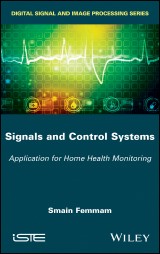Details
Signals and Control Systems
Application for Home Health Monitoring1. Aufl.
|
141,99 € |
|
| Verlag: | Wiley |
| Format: | EPUB |
| Veröffentl.: | 03.01.2017 |
| ISBN/EAN: | 9781119384588 |
| Sprache: | englisch |
| Anzahl Seiten: | 352 |
DRM-geschütztes eBook, Sie benötigen z.B. Adobe Digital Editions und eine Adobe ID zum Lesen.
Beschreibungen
The aim of this book is the study of signals and deterministic systems, linear, time-invariant, finite dimensions and causal. A set of useful tools is selected for the automatic and signal processing and methods of representation of dynamic linear systems are exposed, and analysis of their behavior. Finally we discuss the estimation, identification and synthesis of control laws for the purpose of stabilization and regulation.
<p>Preface ix</p> <p><b>Chapter 1. Control, Servo-mechanisms and System Regulation 1</b></p> <p>1.1. Introduction 1</p> <p>1.1.1. Generalities and definitions 1</p> <p>1.1.2. Control law synthesis 5</p> <p>1.1.3. Comprehension and application exercises 7</p> <p>1.2. Process control 11</p> <p>1.2.1. Correction in the frequency domain 11</p> <p>1.2.2. Phase advance controller and PD controller 12</p> <p>1.2.3. Phase delay controller and integrator compensator 14</p> <p>1.2.4. Proportional, integral and derivative (PID) control 17</p> <p>1.3. Some application exercises 23</p> <p>1.3.1. Identification of the transfer function and control 23</p> <p>1.3.2. PI control 30</p> <p>1.3.3. Phase advance control 33</p> <p>1.4. Some application exercises 36</p> <p>1.5. Application 1: stabilization of a rigid robot with pneumatic actuator 39</p> <p>1.5.1. Conventional approach 41</p> <p>1.6. Application 2: temperature control of an oven 51</p> <p>1.6.1. Modeling and identification study 51</p> <p><b>Chapter 2. System Process Control 55</b></p> <p>2.1. Introduction 55</p> <p>2.2. Modeling 55</p> <p>2.2.1. Introduction 55</p> <p>2.3. Governability, controllability and observability 56</p> <p>2.3.1. Characteristic polynomial, minimal polynomial and Cayley–Hamilton theorem 56</p> <p>2.3.2. Governability or controllability 56</p> <p>2.3.3. Observability 63</p> <p>2.3.4. Observer 68</p> <p>2.3.5. Observer for state reconstruction 69</p> <p>2.3.6. Minimal state–space representation 76</p> <p>2.4. State feedback, control by poles placement and stability 79</p> <p>2.4.1. State feedback control 79</p> <p>2.4.2. Poles placement and stabilizability 80</p> <p>2.4.3. Finite-time response for a discrete system, deadbeat response 83</p> <p>2.4.4. Use of observers in control: separation principle 85</p> <p>2.5. Linear quadratic (LQ) control 86</p> <p>2.5.1. Linear quadratic regulator 89</p> <p>2.6. Optimal control (LQ) 90</p> <p>2.7. Comprehension and application exercises 94</p> <p><b>Chapter 3. Actuators: Modeling and Analysis 117</b></p> <p>3.1. Introduction: electric, hydraulic and pneumatic actuators 117</p> <p>3.1.1. Representation methods for physical systems 118</p> <p>3.1.2. Modeling of a few constituents of physical systems 120</p> <p>3.2. Transmission chains, actuators and sensors 126</p> <p>3.2.1. Electric actuators in robotics 126</p> <p>3.2.2. Motor speed torque characteristic 131</p> <p>3.2.3. Dynamic behavior or transient behavior 131</p> <p>3.2.4. Electric systems motor load 134</p> <p>3.3. Pneumatic actuators 137</p> <p>3.3.1. Pneumatic system modeling 137</p> <p>3.3.2. Frictions model 145</p> <p>3.4. Hydraulic actuators 149</p> <p>3.4.1. System description 149</p> <p>3.4.2. Mechanical model 151</p> <p>3.4.3. Hydraulic actuator model 152</p> <p>3.5. Application exercises 155</p> <p><b>Chapter 4. Digital Control and Polynomial Approach 161</b></p> <p>4.1. Introduction to digital control 161</p> <p>4.1.1. Digital controller synthesis by transposition 162</p> <p>4.1.2. Euler’s transposition 164</p> <p>4.1.3. Choice of the sampling period (Shannon’s theorem) 170</p> <p>4.2. PID controller synthesis and its equivalent digital RST 171</p> <p>4.2.1. Standard controllers 171</p> <p>4.2.2. Study of digital PIDs 172</p> <p>4.2.3. Digital RST controller synthesis 178</p> <p>4.2.4. Choice of poles and zeros to compensate 179</p> <p>4.2.5. Computation of polynomials R, S and T 180</p> <p>4.2.6. Additional objectives for synthesis 181</p> <p>4.3. Digital control by poles placement 182</p> <p>4.3.1. Choice of the sampling period 183</p> <p>4.4. Diophantine, Bézout, greatest common divisor, least common multiple and division 183</p> <p>4.4.1. Polynomial arithmetic 183</p> <p>4.4.2. Diophantine equation ax + by = c and Bachet–Bézout theorem 184</p> <p>4.4.3. Bézout’s identity 185</p> <p>4.4.4. Greatest common divisor 185</p> <p>4.4.5. Least common multiple 185</p> <p>4.5. A few comprehension and application exercises 186</p> <p><b>Chapter 5. NAO Robot 193</b></p> <p>5.1. Introduction 193</p> <p>5.2. Home care project 194</p> <p>5.2.1. Choregraphe software 194</p> <p>5.2.2. Nao Matlab SDK research 199</p> <p>5.2.3. Nao and home care 206</p> <p>5.2.4. The actions to be made 207</p> <p>5.3. Details of the various programs 208</p> <p>5.3.1. Ask for news 208</p> <p>5.3.2. CallFirefighters box 212</p> <p>5.3.3. CallNeighbor box 213</p> <p>5.3.4. CallFamily box 215</p> <p>5.3.5. Collision detection 215</p> <p>5.3.6. Special actions: waking-up 216</p> <p>5.3.7. Morning hygiene 220</p> <p>5.3.8. Gymnastics 221</p> <p>5.3.9. Nurse call 225</p> <p>5.3.10. Memory game 227</p> <p>5.3.11. Drugs reminder 232</p> <p>5.3.12. Reading 233</p> <p>5.3.13. Listening to music 235</p> <p>5.3.14. Multiplication game 239</p> <p>5.3.15. Nao’s dance 243</p> <p>5.3.16. Memory game 245</p> <p>5.3.17. Detect person on the ground 247</p> <p>5.3.18. At any time 251</p> <p>5.4. Conclusion 253</p> <p>5.4.1. Nao’s limitations and possible improvements 253</p> <p><b>Chapter 6. Application Problems with Solutions 255</b></p> <p>6.1. Exercise 6.1: car suspension 255</p> <p>6.1.1. Modeling 256</p> <p>6.1.2. Analysis 257</p> <p>6.2. Exercise 6.2: electromechanical system 259</p> <p>6.2.1. Modeling 260</p> <p>6.2.2. Analysis 262</p> <p>6.3. Exercises: identification and state–space representation 263</p> <p>6.3.1. Exercise 6.3 263</p> <p>6.3.2. Exercise 6.4 265</p> <p>6.3.3. Exercise 6.5 268</p> <p>6.3.4. Exercise 6.6 270</p> <p>6.3.5. Exercise 6.7 276</p> <p>6.4. Exercises: observation and control of nonlinear systems 278</p> <p>6.4.1. Exercise 6.8 278</p> <p>6.4.2. Exercise 6.9 280</p> <p>6.4.3. Exercise 6.10 288</p> <p>6.4.4. Exercise 6.11 291</p> <p>6.4.5. Exercise 6.12 293</p> <p>6.4.6. Exercise 6.13 296</p> <p>6.4.7. Exercise 6.14 300</p> <p>6.4.8. Exercise 6.15 300</p> <p>Bibliography 307</p> <p>Index 313</p>
<strong>Smain FEMMAM</strong>, Director of research (HDR).
Diese Produkte könnten Sie auch interessieren:

Strategies to the Prediction, Mitigation and Management of Product Obsolescence

von: Bjoern Bartels, Ulrich Ermel, Peter Sandborn, Michael G. Pecht

116,99 €

















